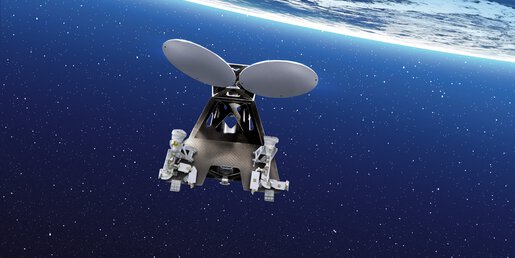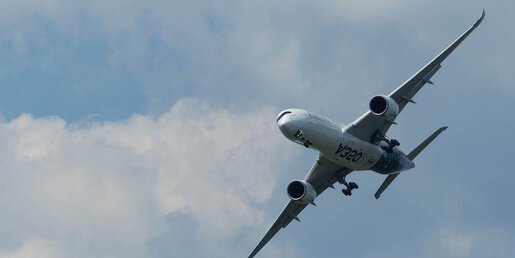Antenna Bracket for RUAG's Sentinel Satellite - Certified for Deployment in Outer Space
For many people, talking of the infinite vastness of the universe conjures up stories of science fiction, usually told by a Hollywood film studio. However, in real life, more than in any other area, it is arguably in space travel that a strong will and clear vision are vital for creating the necessary technology and readying it for deployment in the cosmos. This was the challenge faced by Swiss technology group RUAG in the construction of its Sentinel satellite, designed for observing our planet from on high. Even here, beyond the Earth's atmosphere, additive manufacturing is playing a key role.
To some extent it squares the circle: we have been able to make a component significantly lighter and yet simultaneously more robust. The component characteristics have proven their worth in tests carried out with the requisite stringency for the aerospace sector. We will be hearing a lot more about additive manufacturing in the coming years – I'm convinced of that!
Challenge
Production of an extremely lightweight and robust antenna bracket for Sentinel satellites
According to reports by the German Center for Aerospace (DLR) from 2016, the mission costs of space exploration per kilogram of transported payload are upwards of € 20,000. Every single gram saved reduces total launch costs, as the system requires less fuel for the ascent. As a result, aerospace engineers need to shave every possible gram from every component – as excess weigth accumulates rapidly. In this case, the Swiss RUAG group were in need of an optimally designed antenna bracket.
Yet weight optimization alone is not enough. During a rocket launch, the payload gets well and truly shaken up and the level of vibration is considerable.
Also, the enormous speeds of several thousand kilometers per hour, not to mention the high G-forces, mean that the flight will not be as smooth as you would expect on a passenger jet. Stability and rigidity form a second essential on any specification sheet. Unfortunately this requirement is usually diametrically opposed to the need for lightweight design.
Engineers employ complex structures to identify a workable level compromise between form and weight.
The RUAG team sought the optimum combination of strength and weight for the structure of its antenna bracket, as conventional manufacturing methods had been exhausted.
Thankfully, additive manufacturing provided the perfect possibility of achieving the necessary freedom of design. Component testing represented a particular challenge, not least because of the aforementioned vibration. In outer space, reliability counts, as repairs generally not possible. This also explains why the authorization of such components is such a protracted and complex process. Every certification represents an accolade for the engineers who have achieved it.
Solution
Production of a component using additive manufacturing, which, by virtue of to its complex structures, fulfills all requirements of weight and stability
In such cases, the complete production chain plays an important role, particularly in the aerospace sector. “Obviously, the immense advantages of producing components using additive manufacturing was of great interest to us," explained Franck Mouriaux, General Manager of Structures at RUAG. "For example, design freedom and complex components help us to save weight. The ability to integrate functions is also very helpful. In the end, however, it is a case of identifying these potential advantages, implementing them in an ideal fashion and acquiring the necessary the corresponding authorization. The simplest component serves no purpose if it cannot be used."
Fundamental suitability and rigidity testing formed the starting point of the antenna bracket's design. The next step comprised the selection of material, definition of processes and initial basic tests in respect of the material characteristics. The initial test structures then constructed, to serve as the starting point for the topological optimization of the component. RUAG was eventually able to achieve the – theoretically – perfect form for the antenna bracket, through a combination of intensive work with a CAD and FEM system from Altair and guidance from EOS on design and construction using additive manufacturing.
The approximately 40 cm long antenna bracket was produced by citim GmbH from Barleben in Germany using of the EOS M 400. With a construction volume of 400 x 400 x 400 mm, it was possible to produce two antennas, 30 tensile test pieces and various test items in a single construction order. The construction time was approximately 80 hours. The parameter set used was for a layer thickness of 60 µm, optimized for surface quality and productivity.
The aluminium alloy used, EOS Aluminium AlSi10Mg, is characterized by high strength and strong resistance to dynamic stress, making the material perfectly suited for use with high-stress components. Comprehensive tests were carried out to demonstrate the required characteristics – in the aerospace sector, these comprise up to 80 % of the total scope of a project. Specially manufactured structures were used for testing. Among other things, engineers examined the brackets in computer tomographs. Various mechanical and physical procedures were also performed. At times, the stresses brought to bear on the component deliberately exceeded the load limits, ultimately leading to the destruction of the test pieces.
EOS combines innovation with great experience in additive manufacturing. The systems offer really interesting possibilities for all markets across every sector.
Results
The result of these efforts was that the new antenna bracket for the Sentinel satellites exceeded all expectations. The component was awarded certification and with that, the approval for its utilization in outer space. The achievement is all the more remarkable considering that the use of additive manufacturing in space is still in its infancy.
For example, the component's minimum rigidity requirements wer exceeded by more than 30 % – a margin that is easily sufficient to ensure that, even after a turbulent flight, an ideal antenna position could be attained - and radio communication with Earth guaranteed. The required level of stability was achieved, in part because of the highly uniform stress distribution.
Moreover, the use of additive manufacturing led to a significant reduction in the weight of the final component: down to 940 g from 1.6 kg, representing a saving of over 40 %.
In this instance, the use of innovative technology succeeded in achieving an unlikely combination: improved component characteristics and lower system costs. "We are very happy with the results of this project. We entered unchartered territory on the process side and were rewarded with a stable, lightweight component," says Aerospace Engineer Mouriaux.
"Additive manufacturing has shown that it can fulfill the fundamental procedural demands of space travel. The multiple design advantages and the characteristics of the component itself have certainly proven this. I see great potential for this technology going forward."








